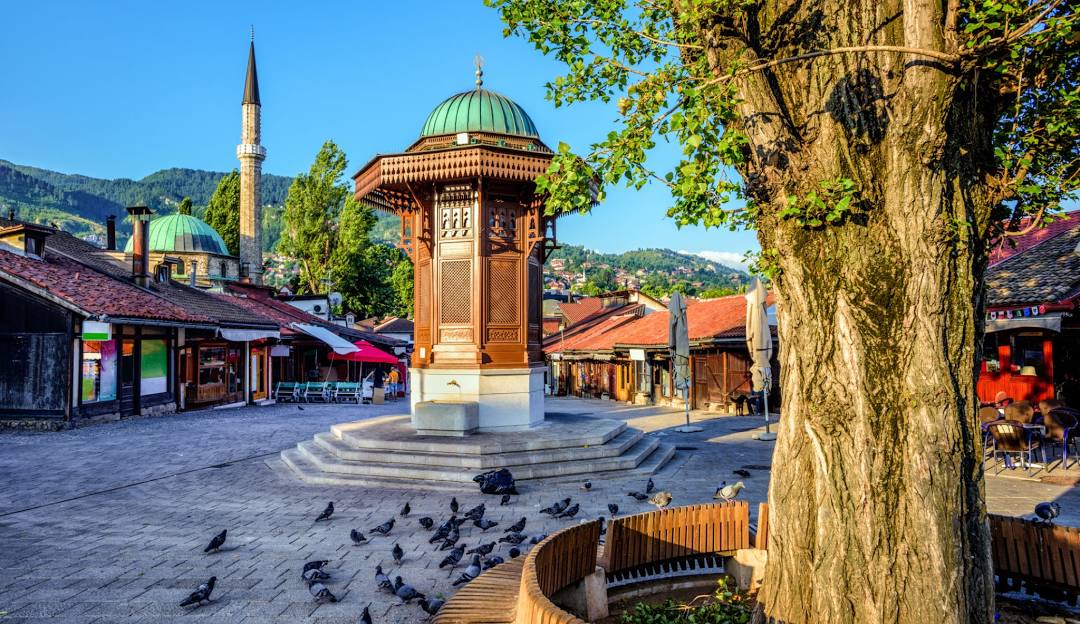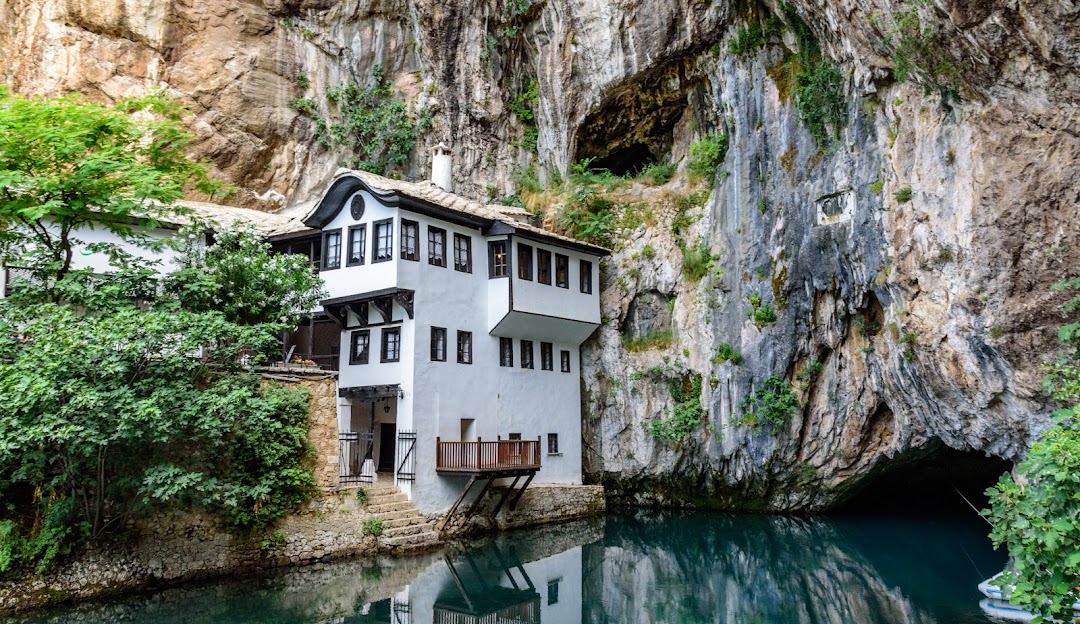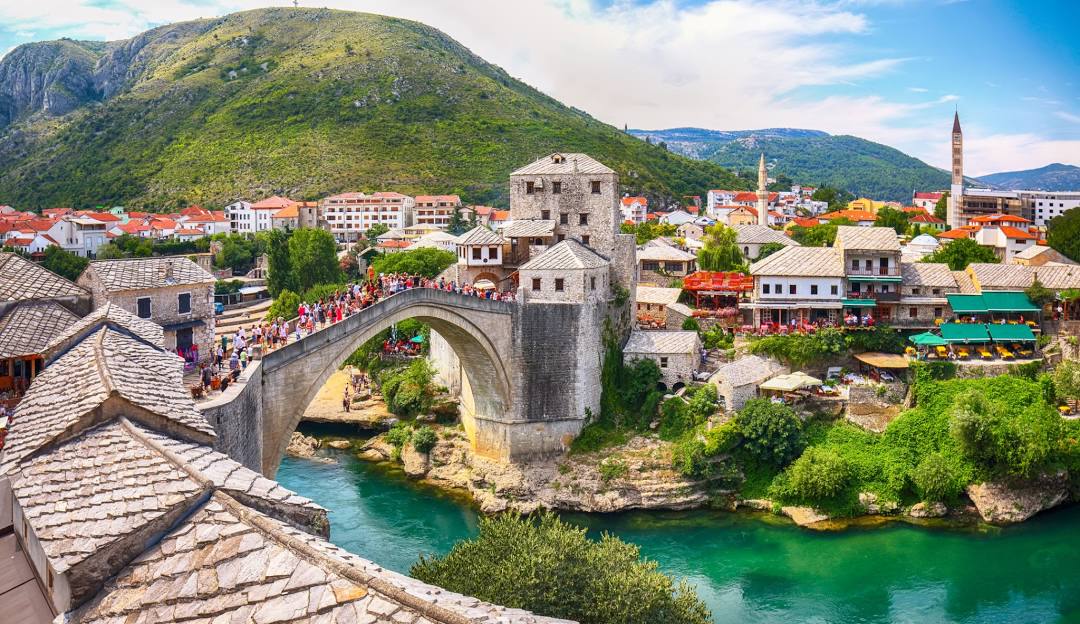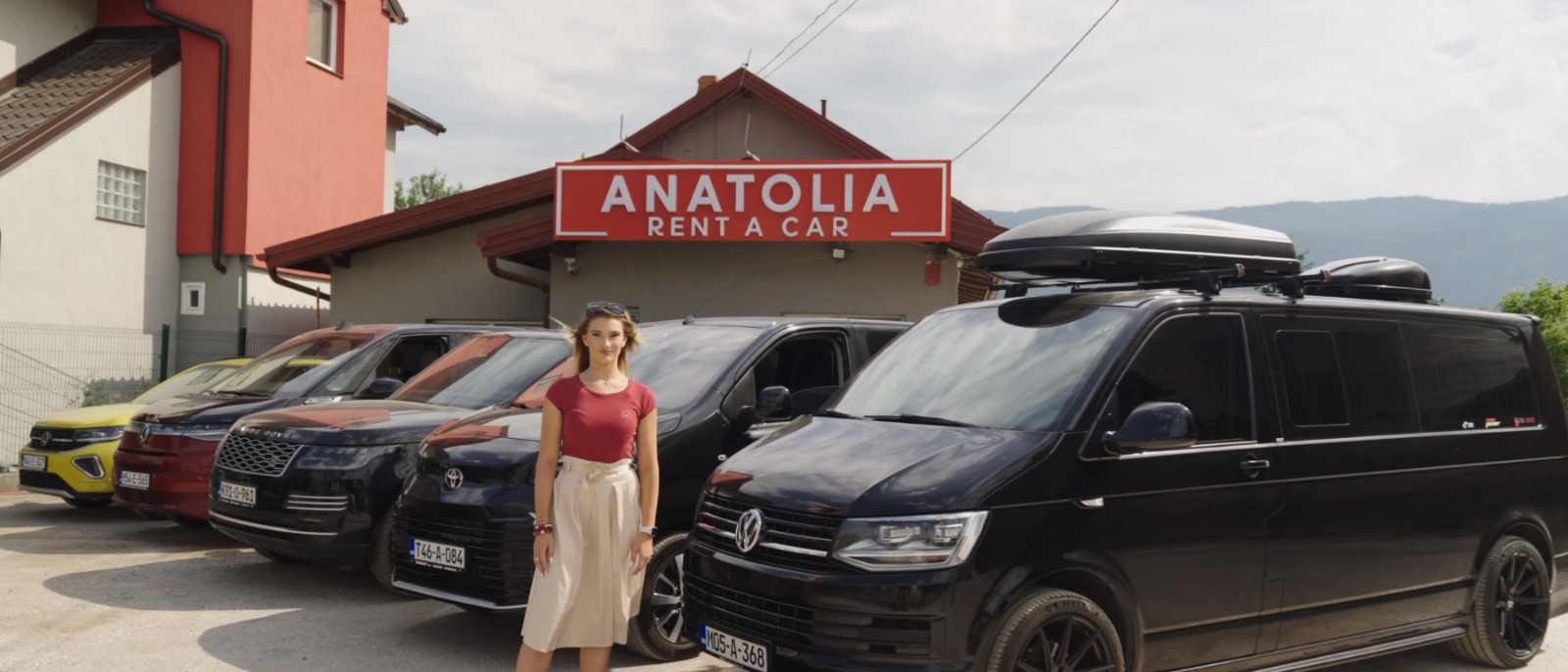
In this article, you can find answers to all your questions such as what to do in Sarajevo, which places to visit, which historical sites to see, where to eat, where to rent a car, and which area to stay in. Be sure to check out our guide to discover routes stretching from Baščaršija to the Latin Bridge, from Ottoman traces to modern life. A comprehensive travel guide awaits those who want to explore Sarajevo from A to Z. If you’re ready, let’s begin…
1. Baščaršija – The Heart of Sarajevo
What to Do in Baščaršija?
You can buy handmade souvenirs, drink traditional Bosnian coffee, and take a walk in the Ottoman atmosphere. This bazaar, made up of just a few streets, can be explored in about an hour.
What Kind of Place is Baščaršija?
Baščaršija is one of Sarajevo’s most iconic and most visited spots. Wandering through the stone streets, coppersmiths, restaurants, and small shops of this historic bazaar, which dates back to the Ottoman period, feels like a journey back in time. This area, beautiful both day and night, offers a chance to experience the cultural texture of the city and taste the most authentic examples of Bosnian cuisine.
History of Baščaršija
Baščaršija was established in the 15th century by the Ottoman governor Isa-Beg Ishaković. Planned as the trade and craft center of Sarajevo at the time, the bazaar gradually became one of the most important economic and cultural hubs in the Balkans. For centuries, it brought together both Muslim and Christian merchants, and it stands today as one of the finest examples of Ottoman urban planning. Inns, mosques, and shops that still stand today preserve the architecture and lifestyle of that era.
2. Sebilj – The Symbol of Sarajevo
What to Do at the Sebilj?
You can take photos in front of this wooden fountain, which has become a symbol of Sarajevo, feed the pigeons around it, and enjoy traditional Bosnian coffee at nearby cafés while soaking in the city’s atmosphere. A short walk around the square where the Sebilj is located lets you observe the historical texture and experience the city’s vibrant energy.
What Kind of Place is the Sebilj?
The Sebilj is one of Sarajevo’s most recognizable landmarks and sits at the center of Baščaršija. This Ottoman-style wooden fountain, surrounded by pigeons, creates a postcard-perfect scene of the city. It serves as a meeting point for both tourists and locals and is a symbolic spot that everyone visiting Sarajevo inevitably stops by.
History of the Sebilj
The Sebilj was built in 1753 by Mehmed Pasha, the governor of Sarajevo at the time. It is a beautiful example of Ottoman fountain architecture and has been restored several times over the years to reach its current form. Known as “Sebilj,” this fountain was once one of many public water sources in the city. Today, it stands as one of the most important symbols representing Sarajevo’s cultural identity.
3. Latin Bridge – Where World War Began
What to Do at the Site Where Franz Ferdinand Was Assassinated?
You can stop at this point where the assassination that changed the course of history took place, examine the exact spot, and visit the museum right next to the bridge. By reading the plaque across from the Latin Bridge, you can learn on-site how this event led to World War I. If you wish, you can also explore the museum’s historical documents and visuals to immerse yourself more deeply in the atmosphere of the period.
What Kind of Place is the Latin Bridge?
This spot is one of Sarajevo’s most intriguing historical sites. On the sidewalk right next to the Latin Bridge, Archduke Franz Ferdinand of Austria-Hungary and his wife were assassinated on June 28, 1914. Today, this area is modest yet carries profound significance, serving as a stop for history enthusiasts. Its quiet surroundings invite you to reflect on the heavy historical weight it bears.
History of the Latin Bridge
On June 28, 1914, a Serbian nationalist named Gavrilo Princip carried out the assassination here, which triggered the start of World War I. This spot in Sarajevo marks the turning point that changed history. Following the assassination, Austria-Hungary declared war on Serbia, setting off a chain of events that led to a massive conflict engulfing all of Europe. Today, the museum and commemorative plaque here present visitors with details and the broader impact of this pivotal event.
4. Vijećnica – Sarajevo City Hall
What to Do at Vijećnica?
You can tour this iconic building, famous for its magnificent architecture, see the exhibitions inside, and deeply feel its dramatic history. In the galleries, you can learn about Sarajevo’s cultural heritage and discover the phases this building has gone through from past to present. Spending time in its domed hall, in particular, offers a visually striking experience.
What Kind of Place is Vijećnica?
Vijećnica is one of Sarajevo’s most impressive structures. Built in the Neo-Moorish style, this elegant building rises along the banks of the Miljacka River. With its colorful facade and graceful arches, it is one of the most photographed landmarks in the city, and its interior is architecturally breathtaking. Today, the building hosts cultural events and exhibitions, serving as both a historical monument and a vibrant art center.
History of Vijećnica
Completed in 1896 during the Austro-Hungarian period as Sarajevo’s City Hall, Vijećnica was later used as the National Library. During the Bosnian War in 1992, it was heavily damaged by attacks from Serbian forces. In this tragic assault, about 2 million books and archival documents were lost. After a long restoration process, it reopened in 2014. Today, it stands as both a historic landmark and a symbol of peace and resilience.
5. Katedrala Srca Isusova – Sacred Heart Cathedral of Sarajevo
What to Do at Sarajevo Cathedral?
You can examine the cathedral’s facade, admire the stained glass and architectural details inside, and sit quietly to feel the peace of this sacred space. The twin towers and Gothic details on the front are perfect spots for photography. If you wish, you can light a candle inside to make your visit more meaningful.
What Kind of Place is Sarajevo Cathedral?
Katedrala Srca Isusova, or the Sacred Heart Cathedral, is the largest and most important Catholic church in Sarajevo. Built in Gothic and Romanesque styles, this impressive structure sits in the city center and is both a cultural and spiritual symbol for locals and tourists alike. The area around the cathedral is also one of the liveliest parts of the city, surrounded by cafes, souvenir shops, and historic streets.
History of Sarajevo Cathedral
Built in 1889 during the Austro-Hungarian Empire, the cathedral is one of the main centers of Catholic faith in Bosnia and Herzegovina. Designed by architect Josip Vancaš, it stands out with its two tall towers adorned with Gothic elements. Although it suffered some damage during the Bosnian War, it was later restored and reopened. Today, it still hosts active religious ceremonies and is an important symbol reflecting Sarajevo’s multicultural identity.
6. Begova Džamija – Gazi Husrev Bey Mosque
What to Do at Gazi Husrev Bey Mosque?
You can spend time in the mosque’s courtyard to closely observe Ottoman architecture, step inside to pray or simply feel the peaceful atmosphere. You can also see the nearby clock tower, visit the adjacent madrasa and mausoleum, and take a short walk among these historical buildings.
What Kind of Place is Gazi Husrev Bey Mosque?
Located in the heart of Sarajevo, this mosque is a popular spot for both tourists and worshippers due to its architectural and historical significance. Representing classical Ottoman architecture, it stands out with its large dome, decorations, and inner courtyard. Its quiet and serene ambiance makes it a perfect escape from the bustle of the city center. Situated within Baščaršija, the mosque is surrounded by many other historical and cultural sites.
History of Gazi Husrev Bey Mosque
Built in 1531 by Gazi Husrev Bey, this mosque is the largest and most important Ottoman-era mosque in Bosnia and Herzegovina. It was designed by Ajem Esir Ali, a student of Mimar Sinan. The mosque was constructed as part of a complex that includes a madrasa, inn, bathhouse, and mausoleum. Damaged during wartime, the building has been preserved through restorations and still functions as an active place of worship today. It also holds great significance as a cultural heritage site.
7. Morića han – Morica Han
What to Do at Morica Han?
You can sit in the courtyard cafés and enjoy Bosnian coffee, experience the atmosphere of an Ottoman-era inn, and browse the small shops selling handmade products. With its quiet and historic feel, it’s an ideal spot to take a break away from the crowds.
What Kind of Place is Morica Han?
Morica Han stands out as the only original Ottoman inn in Sarajevo that has survived to the present day. Located within Baščaršija but set slightly away from the busiest parts, this historic inn—with its courtyard layout and stone floors—feels like a trading stop preserved from the past. Today, it serves both as a cultural site and a space housing small local businesses selling traditional goods. The presence of classic coffeehouses and bookshops adds a nostalgic charm.
History of Morica Han
Built in the 16th century, Morica Han was once an Ottoman inn where merchants stayed and kept their horses. It was one of the key stops along the Silk Road in Sarajevo and is a rare example of Ottoman urban architecture. Despite fires in 1697 and 1957, it has been restored multiple times and survives to this day. Now recognized as a cultural heritage site, Morica Han is an important building that carries the city’s history into the present.
8. Vječna Vatra – The Eternal Flame
What to Do at the Vječna Vatra?
You can stand by the monument where the flame has been burning since 1946 to honor the victims of the Second World War, observe the eternal fire, reflect on its significance, and take photos. The surrounding cobblestone square is peaceful and solemn—perfect for a quiet moment of contemplation.
What Kind of Place is the Vječna Vatra?
The Vječna Vatra, or Eternal Flame, is a simple yet deeply meaningful monument located in the heart of Sarajevo’s historic district. Encircled by a low bronze ring, the flame burns continuously in memory of the city’s WWII victims. It often serves as a landmark where locals and visitors pause during a walk through the old town.
History of the Vječna Vatra
First lit on April 6, 1946—the first anniversary of the Nazi occupation of Sarajevo—the Eternal Flame commemorates all civilians and resistance fighters who lost their lives during World War II. Despite surviving war and occupation, the flame remains lit to this day. Over generations, it has become one of Sarajevo’s most recognized memorials and a symbol of remembrance and endurance.
9. Inat Kuća – The House of Spite
What to Do at Inat Kuća?
You can dine at the restaurant inside this historic house, enjoy Bosnian cuisine, and experience the unique story behind its name. Sitting on the terrace provides a great view of the Vijećnica building across the river.
What Kind of Place is Inat Kuća?
Known as the “House of Spite,” Inat Kuća is one of Sarajevo’s most curious landmarks. This Ottoman-era house was famously moved brick by brick across the river to make way for the construction of Vijećnica, at the insistence of its stubborn owner. Today, it functions as a restaurant and stands as a testament to the city’s colorful folklore and character.
History of Inat Kuća
In the late 19th century, authorities wanted to demolish this house to build the new city hall (Vijećnica). The owner refused to give up his home unless it was moved—stone by stone—to the opposite riverbank. The government agreed, and the house was relocated in 1895. Since then, Inat Kuća has become a symbol of stubborn pride and is now a beloved restaurant serving traditional Bosnian dishes.
10. What to Do at the War Childhood Museum?
What to Do at the War Childhood Museum?
You can witness real memories of war, read stories and see personal belongings of children, and deeply feel the impact of war on civilians. In each room of the museum, there are personal objects accompanied by emotional narratives. This is not just a museum visit; it is a lesson in empathy and humanity.
What Kind of Place is the War Childhood Museum?
Located on a quiet street near the center of Sarajevo, this museum is the first in the world to tell the stories of those who were children during wartime through individual narratives. With a simple yet powerful exhibition layout, it takes visitors on an emotional journey. Every object carries a real story behind it. With its quiet atmosphere and respectful presentation, this museum is one of the most human ways to understand the city.
History of the War Childhood Museum
Opened in 2017, the War Childhood Museum was created with objects donated by individuals who spent their childhood during the Bosnian War. This collection, which explains what it means to be a child in war, includes many personal items and their stories, from toys to notebooks, clothes to letters. The museum offers not only insight into Bosnia, but also a universal perspective on children affected by war. It has received awards from UNESCO and many international institutions and is also introduced worldwide through traveling exhibitions.
11. Sarajevo Roses
What to Do at the Sarajevo Roses?
Stand near the marked sites where bomb craters were filled with red resin, transforming into “roses,” and reflect on the memories of the Siege of Sarajevo. These memorial spots are scattered around the city streets—pause at each one, read any nearby plaques, and allow yourself a moment of quiet contemplation.
What Kind of Place Are the Sarajevo Roses?
Sarajevo Roses are simple yet poignant memorials honoring victims of shelling during the Bosnian War. These red markings fill bomb crater scars in asphalt, serving as both a reminder of tragedy and a symbol of resilience. Often found at ordinary crosswalks or corners, they blend into daily life while carrying deep emotional significance.
History of the Sarajevo Roses
After the war, the city began filling numerous wartime shell craters with red resin to commemorate the lives lost during the siege. Each “rose” marks a spot where civilians died as a result of shelling. Over time these memorials have become widespread across Sarajevo, offering a silent tribute that melds seamlessly into the urban fabric and keeps the past visibly present.
12. Sarajevski Ratni Tunel – Tunnel of Hope
What to Do at the Tunnel of Hope?
You can walk through a section of the tunnel, examine wartime objects and images, and listen to real stories about the hardships people endured during the Bosnian War. You can join guided tours to learn details about the period and watch a short documentary in the video room that shows the impact of the war on Sarajevo.
What Kind of Place is the Tunnel of Hope?
Located in Sarajevo’s Ilidža district, the Tunnel of Hope may look like an ordinary house from the outside, but once inside, it turns into a time capsule taking you into the heart of the war. The tunnel interior is narrow, dim, and silent, giving visitors a real sense of what it felt like back then. The tunnel and its surroundings have been turned into a museum, displaying many objects from the war period such as weapons, clothes, and letters.
History of the Tunnel of Hope
The Sarajevski Ratni Tunel, or Tunnel of Hope, was built in 1993 during the siege of Sarajevo to connect the city with the outside world. This narrow, 800-meter tunnel passed beneath the airport, serving as a secret passage between the besieged city and free territory. Through this tunnel, humanitarian aid, food, medicine, and weapons could be brought into the city. It was also used to evacuate the wounded and civilians. Today, a 20-meter section of the tunnel remains open to visitors and stands as one of the most important historical legacies reflecting the spirit of solidarity and resistance during the war.
13. Sarajevska žičara – Trebević Cable Car
What to Do at Trebević?
You can take the cable car from Sarajevo city center to the mountain to enjoy stunning views, go on nature walks, explore the old Olympic bobsled track, and dine at local restaurants in the fresh mountain air. Especially near sunset, watching the city from above offers a unique experience.
What Kind of Place is Trebević?
Trebević is a natural paradise right next to Sarajevo. Just a 10-minute cable car ride from the city center, this mountain offers peaceful forest paths, clean air, and silence. The cable car journey itself provides a magnificent panoramic view over the Miljacka River and the city’s red-roofed houses. It’s perfect for those wanting to reconnect with nature. The old 1984 Winter Olympics bobsled track is also a special landmark worth visiting here.
History of Trebević
The Trebević Cable Car first opened in 1959 but suffered severe damage during the Bosnian War. After a long hiatus, it was rebuilt and reopened with a modern system in 2018. The cable car line is seen as a symbol of healing from the wounds of war and reconnecting the city with the mountain. For the people of Sarajevo, Trebević is both a place of escape and a symbol of resilience. Today, it is one of the most popular nature destinations for both locals and tourists.
14. Vrelo Bosne – Hidden Paradise
What to Do at Vrelo Bosne?
You can stroll along the riverbanks, enjoy the crystal-clear springs, and relax in the shade of tall chestnut trees. Renting a bike or pony is an option, and there are picnic areas where you can enjoy a peaceful outdoor meal. Don’t miss a boat ride on the calm Bosna River as it emerges from the springs!
What Kind of Place Is Vrelo Bosne?
Vrelo Bosne is a lush natural oasis located at the foot of Mount Igman, just outside Sarajevo’s city limits. It’s renowned for its pristine water springs, greenery, walking paths, and park-like atmosphere. This site is a popular escape from urban life and offers a mix of tranquility and scenic beauty. Families, couples, and nature lovers all find it a refreshing retreat.
History of Vrelo Bosne
The name “Vrelo Bosne” means “Source of the Bosna,” referring to the springs that form the headwaters of the Bosna River. While the site has been cherished for centuries, it became a designated public park during the Austro-Hungarian period in the late 19th and early 20th century. Today, the park is protected as a natural and cultural monument, showcasing the region’s rich ecological and historical heritage.





